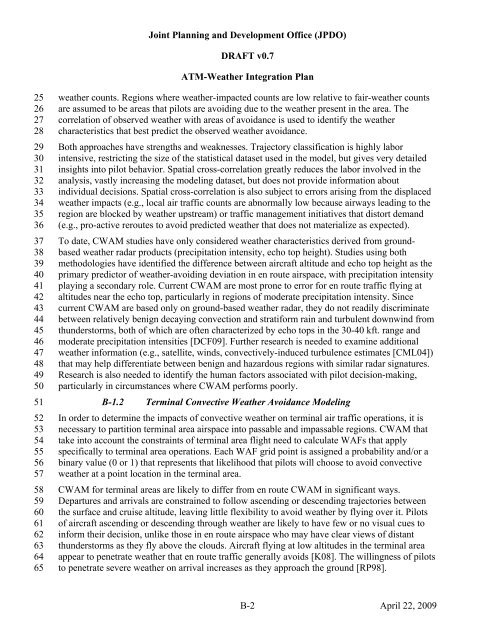ATM-Weather Integration Plan - Joint Planning and Development ...
ATM-Weather Integration Plan - Joint Planning and Development ...
ATM-Weather Integration Plan - Joint Planning and Development ...
Create successful ePaper yourself
Turn your PDF publications into a flip-book with our unique Google optimized e-Paper software.
<strong>Joint</strong> <strong>Plan</strong>ning <strong>and</strong> <strong>Development</strong> Office (JPDO)<br />
DRAFT v0.7<br />
<strong>ATM</strong>-<strong>Weather</strong> <strong>Integration</strong> <strong>Plan</strong><br />
25<br />
26<br />
27<br />
28<br />
29<br />
30<br />
31<br />
32<br />
33<br />
34<br />
35<br />
36<br />
37<br />
38<br />
39<br />
40<br />
41<br />
42<br />
43<br />
44<br />
45<br />
46<br />
47<br />
48<br />
49<br />
50<br />
51<br />
52<br />
53<br />
54<br />
55<br />
56<br />
57<br />
58<br />
59<br />
60<br />
61<br />
62<br />
63<br />
64<br />
65<br />
weather counts. Regions where weather-impacted counts are low relative to fair-weather counts<br />
are assumed to be areas that pilots are avoiding due to the weather present in the area. The<br />
correlation of observed weather with areas of avoidance is used to identify the weather<br />
characteristics that best predict the observed weather avoidance.<br />
Both approaches have strengths <strong>and</strong> weaknesses. Trajectory classification is highly labor<br />
intensive, restricting the size of the statistical dataset used in the model, but gives very detailed<br />
insights into pilot behavior. Spatial cross-correlation greatly reduces the labor involved in the<br />
analysis, vastly increasing the modeling dataset, but does not provide information about<br />
individual decisions. Spatial cross-correlation is also subject to errors arising from the displaced<br />
weather impacts (e.g., local air traffic counts are abnormally low because airways leading to the<br />
region are blocked by weather upstream) or traffic management initiatives that distort dem<strong>and</strong><br />
(e.g., pro-active reroutes to avoid predicted weather that does not materialize as expected).<br />
To date, CWAM studies have only considered weather characteristics derived from groundbased<br />
weather radar products (precipitation intensity, echo top height). Studies using both<br />
methodologies have identified the difference between aircraft altitude <strong>and</strong> echo top height as the<br />
primary predictor of weather-avoiding deviation in en route airspace, with precipitation intensity<br />
playing a secondary role. Current CWAM are most prone to error for en route traffic flying at<br />
altitudes near the echo top, particularly in regions of moderate precipitation intensity. Since<br />
current CWAM are based only on ground-based weather radar, they do not readily discriminate<br />
between relatively benign decaying convection <strong>and</strong> stratiform rain <strong>and</strong> turbulent downwind from<br />
thunderstorms, both of which are often characterized by echo tops in the 30-40 kft. range <strong>and</strong><br />
moderate precipitation intensities [DCF09]. Further research is needed to examine additional<br />
weather information (e.g., satellite, winds, convectively-induced turbulence estimates [CML04])<br />
that may help differentiate between benign <strong>and</strong> hazardous regions with similar radar signatures.<br />
Research is also needed to identify the human factors associated with pilot decision-making,<br />
particularly in circumstances where CWAM performs poorly.<br />
B-1.2 Terminal Convective <strong>Weather</strong> Avoidance Modeling<br />
In order to determine the impacts of convective weather on terminal air traffic operations, it is<br />
necessary to partition terminal area airspace into passable <strong>and</strong> impassable regions. CWAM that<br />
take into account the constraints of terminal area flight need to calculate WAFs that apply<br />
specifically to terminal area operations. Each WAF grid point is assigned a probability <strong>and</strong>/or a<br />
binary value (0 or 1) that represents that likelihood that pilots will choose to avoid convective<br />
weather at a point location in the terminal area.<br />
CWAM for terminal areas are likely to differ from en route CWAM in significant ways.<br />
Departures <strong>and</strong> arrivals are constrained to follow ascending or descending trajectories between<br />
the surface <strong>and</strong> cruise altitude, leaving little flexibility to avoid weather by flying over it. Pilots<br />
of aircraft ascending or descending through weather are likely to have few or no visual cues to<br />
inform their decision, unlike those in en route airspace who may have clear views of distant<br />
thunderstorms as they fly above the clouds. Aircraft flying at low altitudes in the terminal area<br />
appear to penetrate weather that en route traffic generally avoids [K08]. The willingness of pilots<br />
to penetrate severe weather on arrival increases as they approach the ground [RP98].<br />
B-2 April 22, 2009

















